SPECIAL TOOL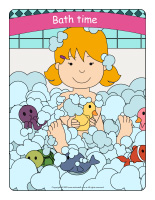
Personal hygiene routine
(Open personal hygiene routine) Print and break all the elements of a daily routine down into steps. Illustrate them by placing the illustrations in the correct order, one after the other. Use the illustrated routine to track children’s progression throughout the day.
CIRCLE TIME
I can talk about personal hygiene…with a puppet
Use a puppet to encourage children to speak about subjects related to the theme. The puppet may help certain children overcome their shyness. It can also be useful for children who require language support. One thing is certain, the puppet will make children want to participate in the discussion!
Flipogram-Personal hygiene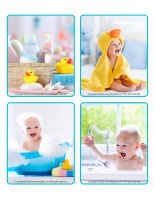
(Open picture game-Personal hygiene) Print and laminate the pictures in the format you prefer. Use a hole-punch to make a hole in the upper right and left corner of each picture. Stack the pictures and insert a ring through each set of holes. The flipogram is easy to manipulate. Simply show children how they can lift a picture and flip it under the stack. Name each item with your group. Use the flipogram to encourage children to talk during circle time and to ask them questions about the theme.
A treasure hunt to discover the theme
(Open educa-decorate-Personal hygiene) Print and laminate. Set the illustrations on items throughout the daycare. Invite children to search for them. Name the items and invite children to guess the theme.
AREA SETUP
Thematic poster-Personal hygiene
(Open thematic poster-Personal hygiene) Print, laminate, and display where children and parents are sure to see it.
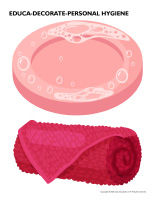
Educa-decorate-Personal hygiene
(Open educa-decorate-Personal hygiene) Print, laminate, and cut out the illustrations. Use them to decorate your walls and set the mood for the theme.
Stickers-Personal hygiene
(Open stickers-Personal hygiene) Print the illustrations on adhesive paper and use them to create a collection of unique stickers. Use them to reward children throughout the theme.
Educa-theme-Personal hygiene
(Open educa-theme-Personal hygiene) Print and laminate the different elements representing the theme. Use them to present the theme to your group (and children’s parents) while decorating your daycare.
Original germ door decoration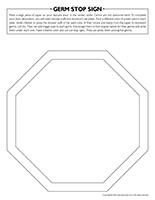
(Open germ stop sign) Print and cut out stop signs. Press a large piece of paper on your daycare door. In the center, write: Germs are not welcome here! To complete your door decoration, you will need shower puffs and aluminum pie plates. Pour a different color of poster paint in each plate. Invite children to press the shower puffs in the paint color of their choice and stamp it on the paper to represent germs. Let dry. They can add wiggly eyes to each germ. Encourage them to find original names for their germs and write them under each one. Have children color and cut out stop signs. They can press them among the germs.
Hygiene wall
Hang a paper banner on a wall and invite children to create a mosaic with pictures of people of all ages and sizes to help increase their awareness about body diversity.
Musical hand washing
(Open 6 steps for hand washing) Print, laminate, and display next to the sink where children usually wash their hands. Play music and encourage each child to wash his hands for the duration of one song. (Open motivation chart-hand washing) Print for each child. Let children add a picture to their chart every time they wash their hands properly.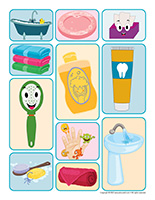
Toothbrushing coloring chart
(Open toothbrushing coloring chart) Print for each child. Use the chart daily to encourage children to brush their teeth. After each meal, invite them to color a box once they have brushed their teeth. At the end of the week, discuss the results.
Ideas for your daycare setup
Hang pictures of body parts from the ceiling. Cut strips of colorful construction paper and link them together to create a chain. Add balloons.
10 items to include in your bathroom:
- A toothbrush holder
- A shelf with holes for storing drinking glasses
- Small hooks for facecloths
- Hand washing poster (Open 6 steps for hand washing)
- An hourglass or timer for when children brush their teeth
- A changing table and a shelf for diapers and baby wipes
- A small footstool next to the sink
- A potty
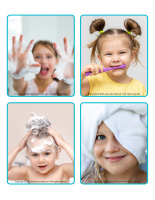
- A basket for each child’s personal items
- A toothbrushing poster (Open toothbrushing poster)
PICTURE GAME
The pictures may be used as a memory game or to spark a conversation with the group. Use them to decorate the daycare or a specific thematic corner. (Open picture game-Personal hygiene) Print, laminate, and store in a “Ziploc” bag or in your thematic bins.
Memory game-Personal hygiene
(Open picture game-Personal hygiene) Print the pictures twice and use them for a memory game.
ACTIVITY SHEETS AND WRITING ACTIVITIES
Activity sheets-Personal hygiene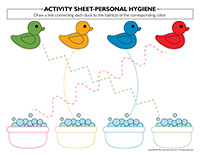
(Open activity sheets-Personal hygiene) Print and follow instructions. If you wish, laminate for use with a dry-erase marker.
Writing activities-H like hygiene
(Open writing activities-H like hygiene) Print for each child or laminate for use with a dry-erase marker.
Creating your own activity binder
Laminate several activity sheets and writing activities and arrange them in a binder along with dry-erase markers. Leave the binder in your writing area and let children complete the pages as they wish. At the end of the day, simply wipe off their work so the activity binder can be reused.
VARIOUS WORKSHOPS-PERSONAL HYGIENE
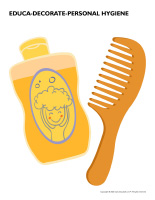
Construction/Building blocks:
- Add facecloths children can use for soft creations.
- Add empty beauty and hygiene product bottles and containers (shampoo, soap, etc.).
Arts & crafts/Drawing:
- Draw on dark construction paper with bars of soap.
- Blow colorful soap bubbles on white paper to create abstract designs.
- Paint with bubble bath.
- Use toothbrushes and toothpaste for a painting activity. Gel toothpaste is interesting on dark paper.
Role play:
- Use a cardboard box to represent a bathtub. Add facecloths, towels, empty shampoo bottles, etc.
- An unbreakable mirror.
- An old hairdryer or a toy version along with hairdressing accessories.
- A bathrobe.
Manipulation: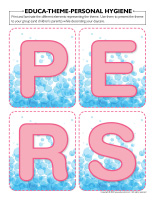
- Memory game with educatall.com picture game.
- Stimulation bottles filled with soap for children to explore.
- Association game. For example, a picture of a child who is brushing his teeth can be associated with a toothpaste illustration.
- Puzzles related to the theme…if you can find them!
- Sequential stories representing the proper hand washing or toothbrushing technique.
Reading/relaxation:
- Books of all kinds…for a relaxing activity.
- Soft music with blankets and pillows.
Sensory bins:
- A large container filled with a mixture of water and soap along with drinking straws children can blow through to produce lots and lots of bubbles.
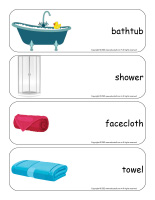
- A container filled with water, bars of soap, and facecloths. Add empty shampoo bottles and a few shower sponges.
- Fill a container with bubble solution and add a variety of instruments children can use to blow bubbles.
LANGUAGE ACTIVITIES
The flashcards may be used during circle time to spark a conversation with the group or in your reading and writing area. They may also be used to identify your thematic bins. (Open word flashcards-Personal hygiene) (Open giant word flashcards-Personal hygiene) bathtub, shower, facecloth, towel, soap, cotton swab, perfume, bubbles, shampoo, germ, toothbrush, toothpaste
Personal hygiene tools
(Open tools-Personal hygiene) Print, laminate, and cut the cards. Show one card at a time and, as a group, children must try to identify the “problem” that must be corrected and select the correct tool, name it, and explain how to use it.
Guessing game-Personal hygiene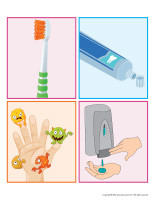
(Open guessing game-Personal hygiene) Print the characters as well as the riddles. Glue each character on a large wooden stick. Fill a small bin with ping-pong balls to represent a bathtub filled with bubbles. Insert the sticks among the bubbles. Read one riddle at a time. Children must identify the correct character. At the end of the activity, let children bring the characters to life. They will enjoy using them to create various scenarios.
ROUTINES AND TRANSITIONS
Scrub those germs
You will need several large Ziploc bags. Draw 2 large hands on each bag. Pour a large quantity of pompoms (different sizes and colors) in each bag. The pompoms shall represent germs. Use wide adhesive tape to secure all 4 corners of each bag to the floor in the hallway where children must wait for their turn to wash their hands. Set a small dishwashing brush next to each bag. Children will enjoy using them to scrub the “germs” and push them outside of the hands to clean them.
Dirty hands/clean hands felt board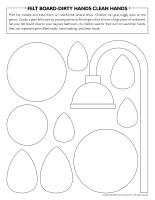
(Open felt board-Dirty hands clean hands) Print the models and trace them on colorful felt several times. Children can glue wiggly eyes on the germs. Create a giant felt board by pressing pieces of felt (single color) all over a large piece of cardboard. Set your felt board close to your daycare bathroom. As children wait for their turn to wash their hands, they can represent germ-filled hands, hand washing, and clean hands.
Visual routine-Potty training
(Open visual routine-Potty training) Print and display the routine where children can easily see it when they go to the bathroom or use the potty. You could even create a small book using rings. Children can manipulate it while they are sitting on the toilet or potty. The visual routine is a great tool for helping children learn the steps involved in potty training.
PHYSICAL ACTIVITY AND MOTOR SKILLS
Doll bath time
Gather several Barbie dolls and liberally apply a layer of Vaseline before sprinkling them with glitter. Tell children that the dolls are covered in germs. Fill a large bin with lukewarm water. Add bubble bath and stir the water to create a thick layer of bubbles. Provide shower puffs, facecloths that you have cut into small squares, and sponges. Encourage children to wash the dolls.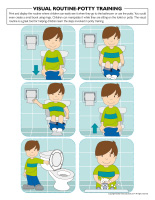
Reproducing germs
(Open reproducing germs) Print, laminate, and cut out the cards. Fill the different sections of a veggie tray with pipe cleaners, wiggly eyes, cotton swabs, necklace beads, buttons, and pompoms. Provide different colors of modeling dough (see illustrated germs for color selection). Children pick a card and use the material to reproduce the illustrated germ.
Modeling dough activity placemats-Personal hygiene
(Open modeling dough activity placemats-Personal hygiene) Print and laminate. Let children pick a placemat and provide modeling dough. Encourage them to use the dough to fill or reproduce the shapes that are on their placemat.
Playing cards-Personal hygiene
(Open playing cards-Personal hygiene) Print and laminate. Give each child the same number of cards. They can take turns hiding them throughout the daycare. Each child then tries to find as many cards as possible.
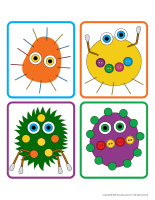
A bathtub in our daycare
Fill a kiddie pool with water and add a few drops of bubble bath along with rubber ducks, colorful facecloths, towels, small boats, etc. Children can wear their bathing suit and pretend to take their bath.
Our towel cabins
Encourage children to use their imagination to build cabins and hideouts with bath towels, chairs, tables, etc.
Goodbye germs!
(Open germs) Print and laminate. Hide the germs throughout your daycare. Set a large jar on the floor, in the centre of your daycare. Children search for the germs. Every time a child finds one, he must drop it in your jar as you quickly remove and replace the lid, pretending you are afraid the other germs will escape.
Musical germs
Arrange several germ illustrations on the floor (Open germs) You must have one illustration less than the number of children in your group, just like in musical chairs. Children dance around the illustrations to the sound of music. When the music stops, children rush to sit on an illustration. The child who is left without an illustration to sit on is eliminated. Remove an illustration and repeat until a single germ is left.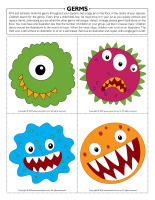
Fine-tooth comb
Show children a variety of items you will hide within your daycare (facecloth, comb, toothbrush, etc.). Have them close their eyes or go to another room while you hide them. When you are ready, invite them to search for the items.
The germ
Divide your group into small teams of two or three children. Each team must pick a child who will pretend to be a germ. When you give them the signal, the other children must wrap their germ in toilet paper, to the sound of music. When the music stops, the winning team is the one with the best-wrapped germ.
Scrub the germs away
Teach children about the importance of cleaning toys to eliminate bacteria. Provide buckets of lukewarm water, dish towels, and facecloths and invite them to help you clean your daycare toys.
COGNITIVE ACTIVITIES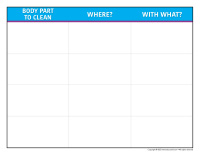
Hygiene: what and where?
(Open grid-what and where) Print for each child. Children must cut out the items and use them to fill the grid. All items on each horizontal row must be related.
Spinner graph-Personal hygiene
(Open spinner graph-Personal hygiene) Print and laminate the spinner and the graph. Children take turns spinning the spinner and finding the corresponding item on the graph. They must set a bingo marker, button, or other item in the correct column. Once everyone has had 1 or 2 turns, count how many times the spinner landed on each item.
Hunt and seek-Personal hygiene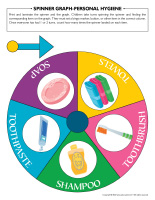
(Open coloring hunt and seek-Personal hygiene) Print and laminate. Children must find and color the items listed at the bottom of the page.
Educ-association-Personal hygiene
(Open educ-association-Personal hygiene) Print and laminate the document. Cut out the characters and the body parts. Press Velcro behind the latter before hiding them throughout your daycare. Children press them on the characters.
For bath time, I need…
Children take turns saying, “For bath time, I need…” and completing the sentence with an item such as soap, a facecloth, a bath towel, bubble bath, etc. Each child must name all the items previously stated before adding one of his own.
Simon says…
Play “Simon says…” with your group, instructing them to wash the germs off different body parts (ears, feet, elbows, etc.).
Toothbrush sort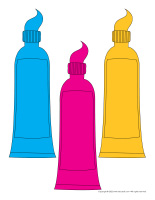
Purchase several toothbrushes (bold colors). (Open colorful toothpaste) Print, laminate, and cut out the toothpaste tubes. Set the toothbrushes in a bin. Children take turns picking a toothbrush out of the bin and associating it with the toothpaste tube that is the same color.
To each his facecloth
(Open game-To each his facecloth) Print a scene for each child plus a copy for yourself. Print and cut out the cards. You will need scraps of blue, red, yellow, and green fabric. Before you begin, invite children to cut a small square out of each color of fabric to represent facecloths for the characters in the scene. Pick a card and show it to your group. Children must set the correct facecloth on each character, per what is illustrated on the card. Compare your results.
Hand washing counting exercise
(Open hand washing counting exercise) Print and laminate the posters. For each of their peers, children will enjoy counting the actions required throughout the hand washing routine.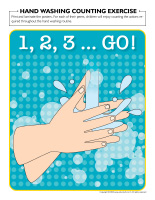
Tricks to simplify this routine
- Offer different types of soap. Select different scents and colors to encourage children to want to wash their hands.
- Colourful facecloths can be used to wash children’s hands and face after snacks or at lunch time.
- Every day, use a special item to make your hand washing routine fun: a sponge, a facecloth, a small brush, etc. Children will look forward to seeing what the daily object is.
- A plastic puppet can be used to add a touch of humor to these routines.
MORAL AND SOCIAL ACTIVITIES
The power of hand sanitizer
Use a permanent marker to draw colorful dots on children’s hands to represent germs. Let dry and invite children to wash their hands with soap. They will notice that, even with a good hand washing technique, it can be difficult to make the “germs” disappear. With constant supervision, apply a drop of hand sanitizer in the palm of each child’s hands and invite them to rub their hands together vigorously. The germs will disappear!
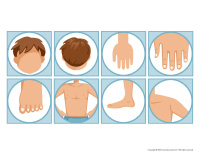
Personal hygiene items
(Open body parts) Print, laminate, and cut out the cards representing different body parts. Fill a bin with various personal hygiene items: shampoo bottles, body wash, dental floss, combs, cotton swabs, facecloths, nail clippers, nail files, etc. Arrange the cards on the table and have children associate each item to the correct body part.
Pump, pump, pump
Ask children to sit at the table or to stand with their back against a wall, close to the sink. You will need different kinds of liquid hand soap. Wrap the bottles so that children can’t see the contents. You will also need a spray bottle filled with lukewarm water. Use the spray bottle to moisten children’s hands. Have each child select a bottle of soap and pump the soap into their hands. Encourage them to lather the soap and guess what the scent is. Children can take turns rinsing their hands at the sink.
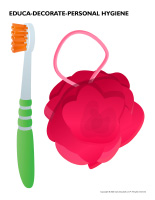
Brush, brush, brush
Purchase several toothbrushes. Use them to create a fun bin and encourage children to use its contents to practice their toothbrushing technique.
Our group’s germ
Provide modeling dough and encourage children to work together to represent a germ. You may also offer pipe cleaners, wiggly eyes, cotton swabs, etc. Let dry and display.
My baby’s bath time
Fill containers with water and let children wash dolls. Provide facecloths and soap.
My comb characters
(Open faces, arms, legs) Print. Purchase a bag of inexpensive combs. Empty its contents in the centre of the table. Children will enjoy gluing the faces, arms, and legs on the combs to represent characters.
Bingo-Dental health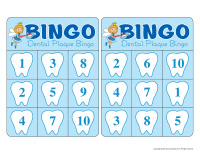
(Open bingo-Dental health) Print and laminate the playing cards as well as the tiny teeth. Cut out the latter. Give each child a bingo card and a dry-erase marker. Children use their marker to draw dots representing plaque on the illustrated teeth (on their bingo card). For example, on the tooth with the number 3 printed on it, they must draw 3 dots. Verify their work and help younger children complete this step. To play, each child will need a toothbrush. Pick a tooth card and ask a child to help you count the plaque (dots). Children then look at their bingo card. Those who see a tooth that has the corresponding number of dots on it “brush” the plaque away. The first child who removes all the plaque on his playing card wins.
Scented soaps
Purchase several different bars of scented soap and encourage children to smell them. If possible, pick scents that children will be able to recognize and invite them to identify them.
OUTDOOR ACTIVITIES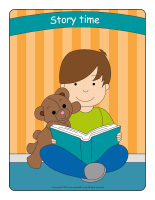
Use sidewalk chalk to draw characters on a paved area in your yard. Next, combine dirt and water to create thick mud and let children spread the mixture on the characters. They will enjoy “washing” them with a garden hose or watering cans.
Personal hygiene item hunt
Hide colorful toothbrushes, hairbrushes, shower puffs, facecloths, soaps, etc. in your yard. Draw circles (corresponding colors) on a paved area in your yard. When you give the signal, children search for items. Every time they find one, the must set it in the circle of the same color.
Towel picnic
Sit on bath towels to enjoy a picnic lunch.
Sponge race
Divide your group into two equal teams. Draw a start and finish line on the ground. Set a bucket filled with water on the start line for each team and drop a sponge inside each team’s bucket. Set an empty bucket on the finish line for each team. Players from each team take turns filling their sponge with water, running to the finish line, and squeezing the water from the sponge into their team’s bucket before running back to hand the sponge to the next child in line. The winning team will be the team with the most water in their bucket at the end of the activity. This activity is great on a hot summer day. Children should wear their bathing suits since they will surely get very wet!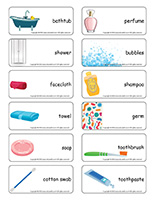
EARLY SCIENCE
It sinks, it floats
Let children play in water. You can simply fill a sink with water and let each child play for a certain period (use a timer to determine the duration). Provide a variety of objects and invite children to manipulate them to discover which items float and which items sink.
Hard soap, soft soap (use children’s soap)
Let children manipulate bars of soap and liquid soap. You can pour a small quantity of liquid soap on paper and encourage children to use it to draw with their finger. Children can use bars of soap to draw on dark paper.
CULINARY ACTIVITIES
The tongue
Children are blindfolded. Have them taste a variety of foods and attempt to guess what they are eating. Repeat the game having them smell the foods instead.
Mr. Potato Head
Use an uncooked potato and decorate it with eyes, nose, and a mouth. Do the same with fruit.
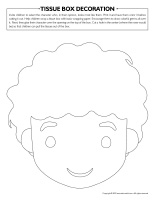
I smell with my nose
Present a variety of spices. Have children smell them and describe each scent.
My hands are having fun
Prepare a recipe of modeling clay with the children in your group. Have them knead the dough.
ARTS & CRAFTS
Tissue box decorating
(Open tissue box decoration) Invite children to select the character who, in their opinion, looks most like them. Print it and have them color it before cutting it out. Help children wrap a tissue box with basic wrapping paper. Encourage them to draw colorful germs all over it. Next, they glue their character over the opening on the top of the box. Cut a hole in the center (where the nose would be) so that children can pull the tissues out of the box.
Hand washing
(Open faucet) Print and cut out the model. Have children trace it on silver or gray felt. They must then cut out their faucet and glue it at the top of a piece of construction paper. Have them trace the contour of their hands on another color of construction paper and cut them out. Children press their index in blue poster paint and make impressions under their faucet to represent drops of water. Next, they glue their hands over the impressions. Display children’s artwork in frames in your bathroom.
Germs multiply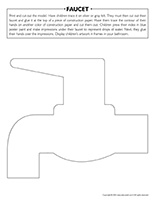
Give each child a piece of heavy white cardboard. Trace one of their hands on their piece of cardboard. Encourage children to set drops of different colors of poster paint that has been diluted with water on their drawn hand. Next, give each child a drinking straw and encourage them to blow in it to spread the paint. The paint may even spread around their hand. Use this activity to discuss how germs spread very quickly.
I blow my nose
(Open craft-I blow my nose) Print for each child. Invite children to color the sweater and draw eyes and a nose on the face. Next, trace each child’s forearms and hands on beige paper. Children cut them out and glue each arm at the tip of a sleeve, applying white glue only at the very end so that the arms can be folded. Children glue a tissue on the nose and fold the hands so they can be glued on the tissue.
My scrapbook
(Open scrapbook) Print several copies of each page. Children color them. Photograph children and add a picture to each of their scrapbooks. Add personalized comments too. Glue the cover page to a piece of cardstock and join the pages together with ribbon or insert the pages in a binder.
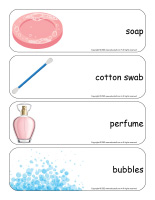
Additional scrapbook pages
Print the measurements scrapbook page. Measure and weigh children. Complete the information and add the page to the scrapbooks. (Open scrapbook measurements)
Handprints and Footprints
(Open handprints and footprints) Print for each child. Make prints using washable ink or paint. Add to their scrapbook.
Right hand, left hand
Begin by showing children they have a left hand and a right hand. Explain that they are to draw a picture first with one hand, and then the other. Use two different papers and write which hand was used to draw each picture. You may prefer to draw a line on a single paper dividing it into two sections and writing which hand was used to draw in each section.
Painting with your back turned
Hang a large piece of paper on the wall for children to paint on. Have them paint facing away from the paper. They must hold their paintbrushes in their hands and paint without looking at their work.
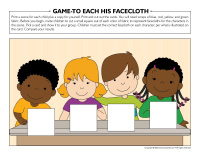
Painting with your feet
Children attempt to paint with their feet. Holding the paintbrushes between their toes, they can produce a masterpiece.
My comb
(Open faces, arms, legs) Print. Purchase a bag of large combs. Present the children with all the material and have them create a character which can be used for a puppet show.
My skeleton moves
(Open skeleton mobile) Print the skeleton parts. Children glue the pieces on construction paper before cutting them out. Use fasteners to tie the joints together so the skeleton can move its arms, legs, and head.
Create an impression
Make impressions of various body parts. Have children compare their impressions: color, size, etc.
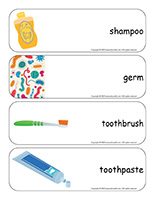
Mix and match
Provide catalogues and magazines. Children cut out heads, bodies, and legs.....Have them create people.
Finger painting
Use tactile paper and finger paint. Allow children to create freely.
Body drawing
Children attempt to draw with unusual body parts such as their toes, knees, elbows...
My silhouette
Use large pieces of paper and have children lie down on them. Trace the contour of their bodies. Cut out the shapes and hang them on the wall. Children decorate their silhouettes as they wish (markers, wooden pencils, fabric, etc.).
COLORING PAGES
(Open coloring pages theme - human body)
SONGS & RHYMES
Head, Shoulders, Knees and Toes
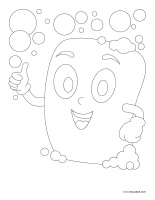
Head, Shoulders, Knees and toes
Knees and toes
Head, shoulders, knees and toes
Knees and toes
And eyes and ears and mouth
And nose
Head, shoulders, knees and toes
Knees and toes
If you’re happy and you know it
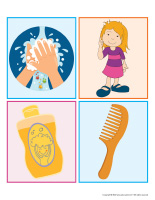
If you're happy and you know it
Clap your hands
If you're happy and you know it
Clap your hands
If you're happy and you know it
And you really want to show it
If you're happy and you know it
Clap your hands
Repeat with:
Stomp your feet
Blink your eyes
Shrug your shoulders
Wiggle your fingers
Shake your head
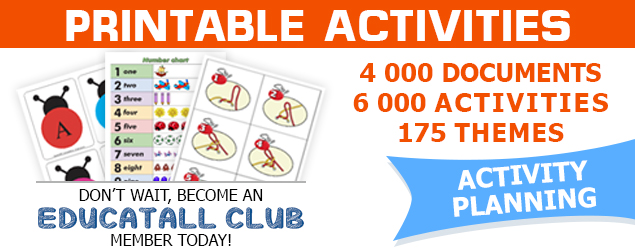
 Home
Home Theme activities
Theme activities
 Babies and toddlers
Babies and toddlers
 Arts and crafts
Arts and crafts
 Science
Science
 Creative recipes
Creative recipes
 Tips and tricks
Tips and tricks
 Special needs
Special needs
 Extra activities
Extra activities
 Educ-TV
Educ-TV
 Newsletter
Newsletter  Online store
Online store Educatall club
Educatall club

